OBD Tuning, Part 2: Can You Really Feel 2-Degrees? (with the CVTz50 app)
TL : DR: I can’t, or not enough.
Long-form Version: See below.
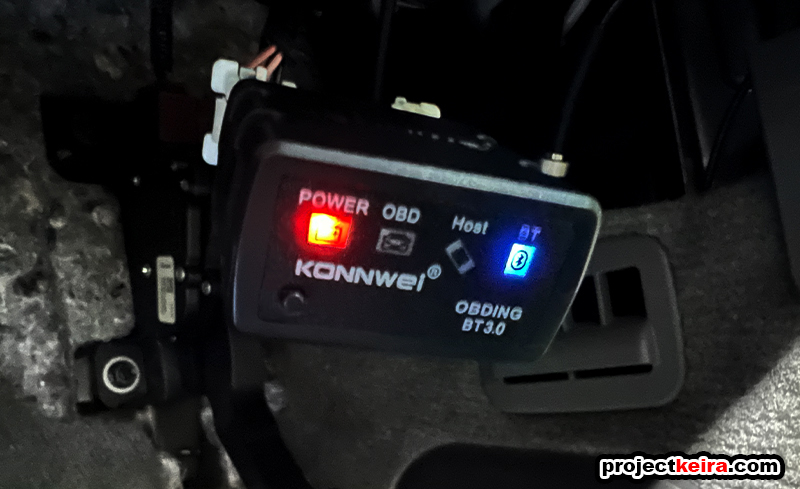
In part 1 of this OBD-II tuning experiment, I focused specifically on adjusting the idle RPM in order to eliminate a small but increasingly annoying vibration issue at idle; thankfully the end result was a success (click HERE to read how it went). Now it was time for part 2: experimenting with the timing adjustment feature.
For those of you who didn’t see the first part of this series, the mods (or adjustments) are being done using a small OBD-2 Bluetooth adapter (I’m using a Konnwei KW902 ELM327 Bluetooth OBD-2 interface purchased on Amazon for $21) and the CVTz50 app on Android ($5), which I have installed on a really old Amazon Fire 7 tablet ($29).
DISCLAIMER: If you choose to do anything described here, you do so at your own risk. I am not liable for anything you choose to do to your truck, and any possible ramifications that may occur based on what you read become solely your responsibility, not mine.
I already covered the installation and basics to get up and running with the OBD-2 adapter in part 1, so I’ll skip the setup portion and get right to it. This time around the focus is the eighth option on the main screen of the CVTz50 app: the Ignition Timing Adjustment:
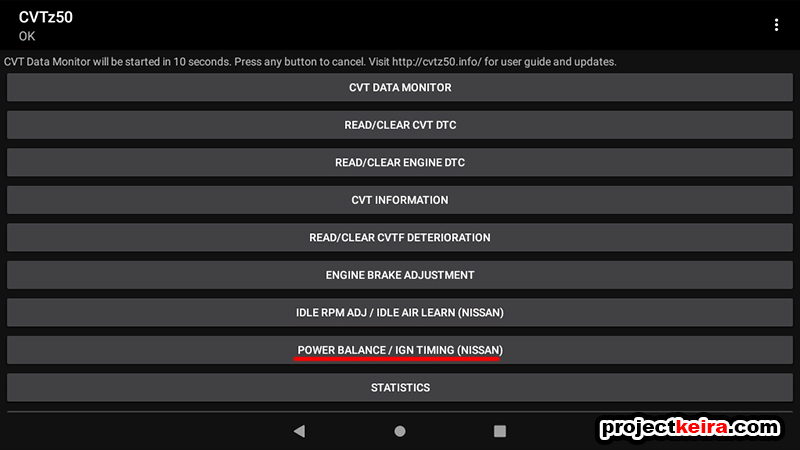
Based on what I knew about how engines work vs. what the Internet claims were, I had some suspicions about using this feature of the app…yet to be fair, I was completely open to being proven wrong if my testing ended up validating what I had read from others.
Quick rewind: as I explained in part 1 thanks to an extended work-related project, I had a pre-planned route that I took each day over the course of about 2 months. The route was a 40-mile round-trip drive (40% freeway and 60% surface roads) with multiple hills and traffic lights along the way. Here’s what the route looked like in terms of elevation changes:
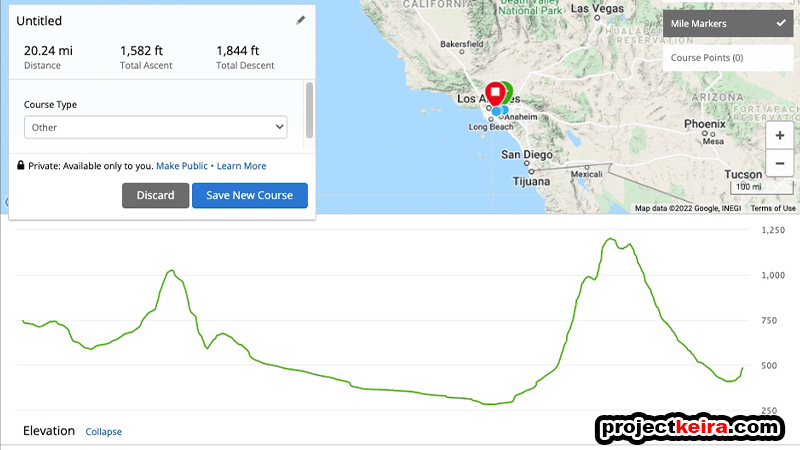
During my experiments, I made a note to myself to try to drive as consistently as possible, the extent of which was already explained in part 1. After spending about 1 month on the idle adjustment experiment, I took a week off and just drove normally. Week 6 was when I began the ignition timing experiment.
IGNITION TIMING: Testing Method Over 21 Days (3 full tanks used)
To remove any chance of the idle ROM mod interfering or affecting the ignition timing mods, I first put the idle RPM back down to the OEM setting. That meant my engine was back to its OEM, “non-CVTz50-modded” form. A long press on “Power Balance / IGN Timing” sent me to the Ignition Timing Adjustment screen. I only had the options to retard or advance the ignition timing by +/- 2 degrees. Since +2 was the highest timing change I could select (and what most people also went straight to when doing the same mod) I tapped +2 and then hit OK.
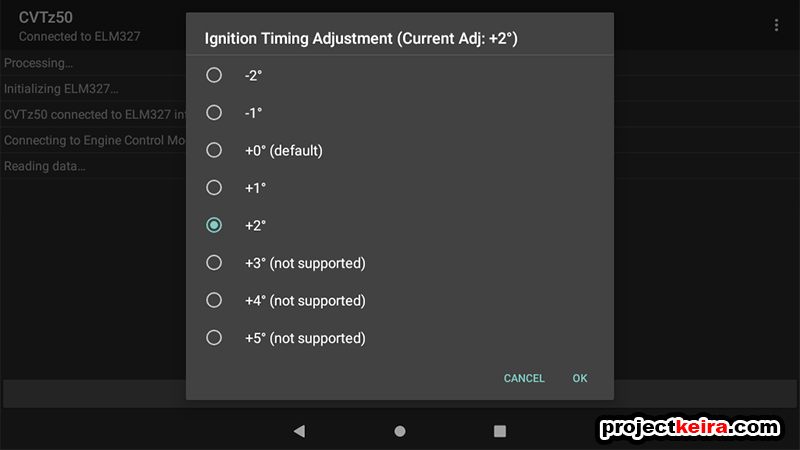
Ignition Timing Adjustment, Week 6 (+2-degrees)
So here I am, driving the same damn route I’ve been driving for the last month (lol), but with the timing adjusted to +2 through the CVTz50 app. I already had a feeling the “butt dyno” effect might kick in because the moment I left my driveway I already had the pre-existing knowledge that a timing adjustment was made. Sure enough, as soon as I got on the throttle after leaving a red-light-turned-green, I thought to myself “did that feel sportier? I think it felt sportier. Did it though?”
What ended up happening (especially during the first 2-3 days) was that along the entire route to the job site I was hyper-aware of every throttle input I made, and if it did or did not feel… sportier. To be honest there were a lot of times when I felt like the Frontier was maybe more responsive to throttle input, and a lot of times where I might have said to myself “hey, the truck feels like it pulled harder than it used to…” or “…doesn’t feel like any lag going up this hill!” and so on.
On the other hand – there were probably an equal number of times when I didn’t notice a thing and my Frontier felt the same as it has since 2014. In fact, during the latter part of the week, I totally forgot about the timing adjustment mod (good thing I set reminders on my calendar)! Once I reached day 7, either I got used to the change in “engine performance” – or the butt dyno placebo effect wore off completely.
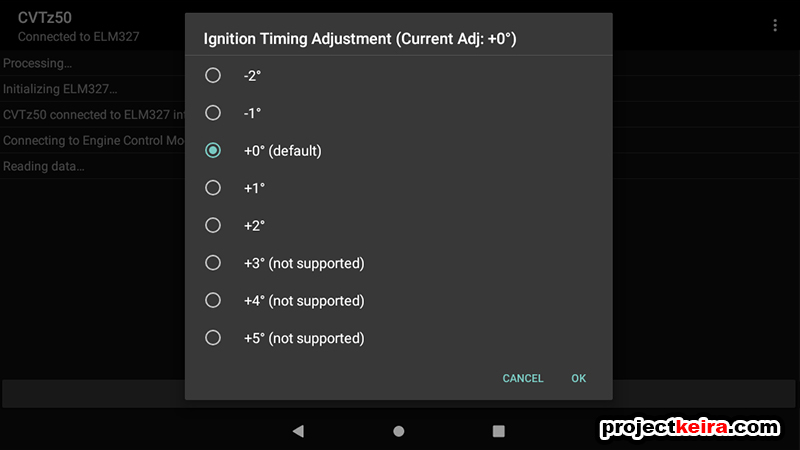
Ignition Timing Adjustment, Week 7 (Back to OEM, 0 degrees of adjustment)
When week 7 began, once again I already had pre-existing knowledge that I had removed the +2-degree timing adjustment, so the chances were that the good old “butt dyno” would work the opposite way and tell me “Your truck is slow, pal.”
Guess what? I didn’t really feel a difference. The truck just drove and felt normal. Acceleration from a green light felt the same as the day before. Punching the throttle on the on-ramp to merge into traffic also felt the same as before. By the third day I questioned if I actually confirmed the reset, so just to be sure I reconnected the CVTz50 app and it was still set at the default 0 degrees of adjustment. Weird.
The last few days I just continued driving, and the throttle response and overall feel of acceleration felt… the same.
Ignition Timing Adjustment, Week 8: Blind Testing with Co-Workers
After experiencing basically nothing (aside from the first day when I thought there was a difference) I decided to try something different: I’d do some blind testing with a few different people just to see if they could notice any difference when I did the timing mod. Three of my co-workers volunteered; 2 of the test subjects were “tuner peeps” who daily drove modified vehicles and the third was a DIY person who took care of their personal vehicle maintenance but was not into any modding. The testing method was as follows:
Each driver would drive 3 laps around a short but specific predetermined route that I mapped out near our work location. The 2-mile route was through a hilly portion of Pasadena, CA which I felt would give ample chances to actually have to use some throttle. Each driver would drive the 3 laps back-to-back-to-back, with a quick break in between laps. This took place over 5 days in total.

LAP 1: The truck was set to stock timing and I told the driver that the truck was set to stock timing, and to pay attention to how my truck felt during acceleration and general throttle inputs -with the intent of using these observations as their baseline. At the end of the first lap, we would park at the start/finish so and then discuss their observations so that I could note the feedback.
LAP 2: I connected the CVTz50 app to the truck and changed the timing to +2-degrees. I also told the driver that I advanced the timing by +2-degrees. As with the first lap, they were to observe for any changes in throttle feel or overall vehicle response during the lap. At the end of the second lap, we parked at the start/finish again to discuss any observations, so that I could note the feedback.
LAP 3: I connected the CVTz50 app to the truck and changed the timing back to stock. However, I did not let the driver see the setting, and I told them that for this third lap they would have to guess in the end if the timing setting was stock or modified. Because the driver saw me connect the app to the vehicle prior to this third lap, they would not know for sure if I made a timing change or not. Just like laps 1 and 2, at the end of this third lap, we would park at the start/finish again to discuss any observations, and so I could note the feedback.
Over two days the test drivers drove a total of 9 laps for the initial portion of the blind test. Yes – one could easily argue that by telling them I advanced the timing beforehand, it would “plant a seed” that a change was made. Through the power of suggestion, since they were told a change was made, it might have swayed them into believing that they could expect to feel some sort of performance change… but that was actually the point (you’ll see why later). We skipped Wednesday, then did another 9 laps over the following two days as described below:
LAP 4-6: Each driver drove for 3 more laps each. I changed the stated method by telling them that this time around they were starting with the modified timing for lap 4, followed by stock timing for lap 5, and finally the same “guess what” scenario for lap 6. However, here’s the kicker:
I lied.
Throughout the entire testing during laps 4-6 I left the truck’s timing at the stock setting. I went through the motions of connecting the app and pretending to make changes on my tablet so that they would see me doing something, but I really wasn’t changing a thing. For laps 4-6 I really wanted to test whether or not the “butt dyno” would come into play. Here are our test results:
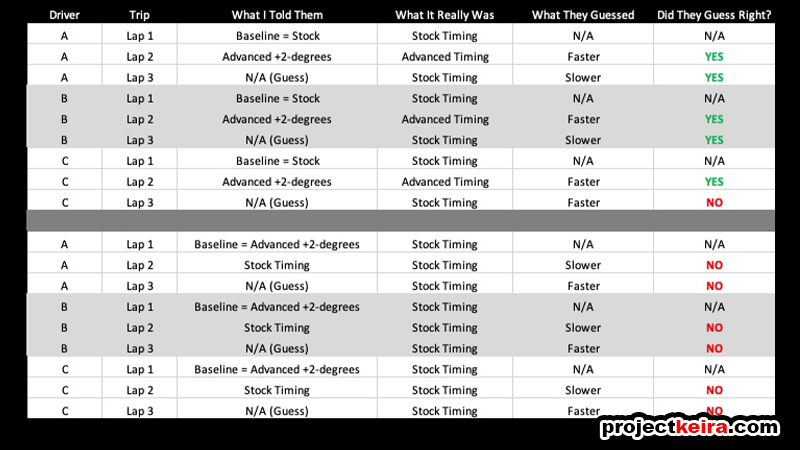
IGNITION TIMING: Blind Testing Results
For the most part, the drivers’ observations matched the intended result during laps 1-3. All 3 drivers claimed they felt an increase in throttle response when I had the timing advanced +2-degrees, and only driver C said that they did not feel any change after I adjusted the truck back to stock. When we take a look at laps 4-6 though – surprise! All 3 drivers guessed wrong!

All 3 drivers felt that changes were made, and went on to describe how the throttle response seemed to increase/decrease, etc. In the end, I told all of them that laps 4-6 were done with stock timing and that I did not change a thing – and all 3 were surprised. The two “tuner” drivers could have sworn that I had changed the timing and that there was a difference, the third driver wasn’t so sure.
IGNITION TIMING: Gas Mileage Impact?
During the “Idle Adjustment” testing of the CVTz50 app during weeks 1-5, my best MPG was 15.89. After going through a tank of gas during week 6 with the truck set to +2-degrees, the calculated miles per gallon during that week dropped to 14.67 MPG (I did not calculate MPG during the blind testing week since the truck was being driven by others and on different routes.)

Is roughly 1 MPG a big difference? Based on my data and using 18 gallons as a reference point, the math shows this:
- Stock timing, 15.89 MPG, over 18 gallons of fuel = 286.02-mile range
- +2 timing, 14.67 MPG, over 18 gallons of fuel = 264.06-mile range
- Range difference: +21.96-miles with stock timing
To look at this from a cost perspective, to get the same 286.02-mile range with the +2 timing advance, the math says you will need 19.49-gallons – a difference of +1.49-gallons over stock timing needing only 18 gallons. Using a rate of $5.59/gallon as a reference point, the cost difference would be as follows:
- Stock timing @ 18-gallons of fuel @ $5.59/gallon = $100.62
- +2 timing @ 19.49-gallons of fuel @ $5.59/gallon = $108.95
- Cost difference: +$8.33 per tank
Of course, realistically one can easily change your tank-to-tank MPG simply by altering how you use the gas pedal, what speed you drive on the freeway, etc. but considering how high current gas prices are, I feel like $8.00+ is a significant difference in spending for each visit to the pump.
IGNITION TIMING: Hey yo where’s them Dyno Numbers and 0-60 Times?
So how does one test the mod more objectively? One suggestion was to do dyno runs; another suggestion was to do some 0-60 and/or ¼-mile acceleration testing. Both are excellent ideas… but I didn’t do either of them. Although I do have access to a 4-wheel dyno, I wasn’t really interested at all in seeing if this mod made more horsepower. Likewise, I could care less if the timing mod made my truck faster in the ¼ mile.

If someone else wants to pay the dyno fees or find a place to do multiple full-throttle runs in order to test the timing mod, then by all means please – feel free to do it and report your own findings! But for me, my truck is a truck – not a race car.
CONCLUSION: I Think I’ll Pass on This One
There were various claims about this mod, with most of the comments being that the Frontier’s VQ40 had more “pep”, that it had quicker throttle response, or even that it was faster in the ¼-mile, or that gas mileage improved. And for clarity, the whole point of these experiments was not to debunk other people’s results or observations, but for the purpose of seeing what results I would get myself with my truck, and if there were any improvements achieved.
The Blind Testing experiments I did with my co-workers were actually pretty fun to do, and I am fully aware that though the bulk of those test results was subjective, they were still valid and useful data that I incorporated into my analysis of this mod.
I’m sure someone will inevitably reply to this thread with different results – and that is fine. I’d rather there be more data available than having less, whether it’s objective or subjective. Going into this, I wanted to specifically test the subjective parts of this mod because that’s mostly what I was reading on the forums; a lot of the claims were that the advanced timing made their Frontier feel better, or faster, or both… was also subjective.
So back to the conclusion – what do all of these casually scientific experiments tell me? If anything, it shows how easily the good old butt dyno can influence observation; I’m pretty sure that the pre-lap verbal notifications (telling them a change was made) and visual cues (them observing me connect the tablet to the app to make “changes”) mixed in with the placebo effect made all 3 drivers feel like something had changed in the truck’s throttle response during each lap they drove, whether or not I actually changed the timing. So was the truck really more responsive with increased throttle response after adding the +2-degree timing mod? As my solo testing and the blind testing showed, it seems a lot of the “improvement” is based on feeling.
Advancing timing is nothing new – I remember when I was younger how we would fiddle with the position of the distributor in order to try to squeeze the most power out of our track cars. This tuning adjustment trick has been done for decades now, and still applies today – albeit nowadays through modern technology with direct-fire ignition systems and ECU fuel controller mods. So while even in 2022 precise timing changes are required when dealing with true competition engines that have beefed-up engine internals, add-on forced induction like a turbo or supercharger kit, overbore stroker kits, high-comp cam upgrades, etc…
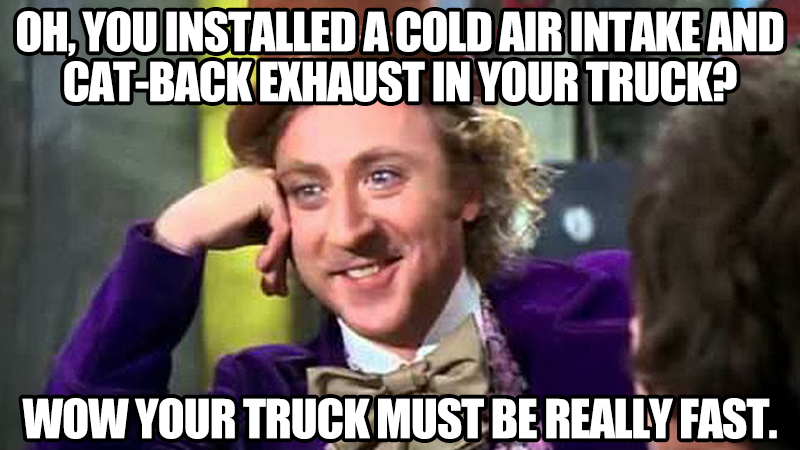
…but on a daily driven, stock truck or one with at most a few bolt-on mods? Personally, I don’t think my truck needs it. The OEM ECU can already automatically adjust the timing to compensate for mild bolt-ons (cat-back exhaust, “cold-air” intakes, and even throttle body spacers) without having to trick it into an advanced timing situation. When I added +2-degrees I really couldn’t tell much of a difference myself, and the blind drive testing with my co-workers also reinforced what I experienced. So, with that said, for those who want to try to eek out any tiny gain by turning the timing up, you can easily do it with the CVTz50 app.
But for me? I’ll keep this setting at stock =)